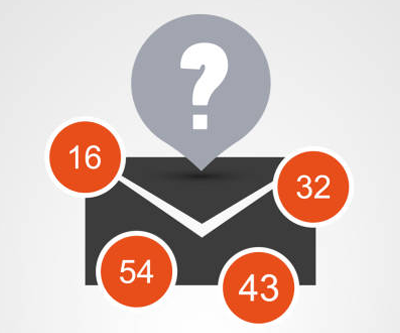Permission based email marketing is a concept everyone can relate with – whether you’re a marketer or not.
Let’s start with a quick definition. Permission based email marketing means that a company receives consent from a subscriber to send them commercial email marketing messages.
How many times have you inadvertently signed up for a company’s email list – and by the time you realize you’ve done so, your inbox is already overflowing with emails?
Or how about all the emails you receive after providing your email address for a giveaway (no judgment, we’ve all done it a few times).
Or how about all the emails you receive after providing your email address for a giveaway (no judgment, we’ve all done it a few times).
While it’s disappointing to receive a barrage of emails when you have zero recollection of signing up, it’s even worse when you click “manage my preferences” and are given only one option – to unsubscribe. Or perhaps the options they have provided just aren’t right for you!
Or, what if you can’t even find an unsubscribe button!
As you read this you may be nodding your head or just thinking “Yes, that’s happened to me!” We’ve all felt the pain of receiving emails we didn’t sign up for – but what about the times when you receive a follow-up email actually confirming that you want to receive emails?
While it might seem like a pain to click the button and confirm that you want to hear from a company – it’s actually a good thing. It shows that the company emailing you is interested in whether or not you agree to receive emails from them.
Sending emails to contacts who you do not have permission to email can cause issues for several reasons. For example, if you do not have explicit permission to email someone, they may get annoyed, and will probably mark your emails as spam!.
Keep reading to learn why permission matters, how to obtain permission, email marketing laws and regulations you should be aware of, and best practices for building an email marketing list.
Why Does Permission Matter?
In addition to avoiding spam complaints, blacklists, and generally unhappy contacts; taking the time to obtain permission will go a long way.
For example, your emails will likely receive better open and click-through rates. Research has shown that permission-based email open rates is around 30-40%, while open rates for those who did not give permission is closer to 2%.
You’ll also notice an improvement in the return on investment for your email campaigns. Whether you’re paying for an email service, an agency to create and manage email campaigns, or perhaps both, there’s potential for wasted time and money when the contacts you’re sending emails to are not receptive.
Finally, sending emails to contacts who are marking them as spam can negatively affect your deliverability rates. By sending to only contacts who have provided permission, the chance that they will mark your emails as spam will decrease.
Why Does Permission Matter?
In addition to avoiding spam complaints, blacklists, and generally unhappy contacts; taking the time to obtain permission will go a long way.
For example, your emails will likely receive better open and click-through rates. Research has shown that permission-based email open rates is around 30-40%, while open rates for those who did not give permission is closer to 2%.
You’ll also notice an improvement in the return on investment for your email campaigns. Whether you’re paying for an email service, an agency to create and manage email campaigns, or perhaps both, there’s potential for wasted time and money when the contacts you’re sending emails to are not receptive.
Finally, sending emails to contacts who are marking them as spam can negatively affect your deliverability rates. By sending to only contacts who have provided permission, the chance that they will mark your emails as spam will decrease.
Permission to Send Email
The good news is that you’re taking a step in the right direction by making yourself more aware of the importance of getting permission for sending emails as well as how to put it into action!.
Here are a few best practices so you can get started.
1. Double opt-in
A simple, but fail-proof way to ensure that you have a contact’s permission is the double opt-in email. Once a contact has entered their email address somewhere on your website – whether that’s a pop-up or landing page form, you immediately follow up with a confirmation email containing a message along the lines of, “Are you sure you want to subscribe?”
Typically email marketing software will have a setting in place so that you can easily send this double opt-in email.
2. Allow users to choose the frequency and type of emails
In addition to double opt-in, it’s important to provide contacts a way to choose how often they receive emails as well as the types of emails.
For example, you can allow users the ability to control the frequency of receiving emails daily, weekly, or monthly. For content types, you can provide options such as newsletters, promotions and offers, coupons and discounts, company news, and more.
3. Your contacts should be able to manage preferences
While contacts might initially choose the frequency and types of emails they want to receive from your company, things can change, so you should always make it easy for your contacts to update and manage their preferences. You can choose to provide a link at the bottom of each of your emails so that recipients can update their preferences at any time.
If they’re unhappy with how often or the certain types of emails they are receiving, they will be less likely to unsubscribe if they have the ability to manage it.
4. Ensure there is an easy way to unsubscribe
Lastly, providing a clear way for contacts to unsubscribe is another essential part of permission-based email marketing.
As mentioned above, if contacts cannot find how to manage preferences or unsubscribe from your emails, the likelihood that they will mark your email as spam increases.
Taking it a step further, you can also send an email once or twice a year to all contacts, asking them if they’re still interested in receiving emails from your company. You might be thinking, so now you’re asking me to deliberately ask the contacts I’ve worked for to leave our list? It might sound crazy, but by providing unengaged contacts with a way out and asking others to confirm they want to stay on your list, you’ll be surprised with the results.
Yes, you will lose contacts – but what good are contacts who aren’t interested? If they are not engaged, they will ultimately become lukewarm toward your content anyway. Focus on the contacts who love your brand and you’ll see a higher amount of opens, better click-through rates, increased engagement, and ultimately – increased sales.
Email Marketing Laws and Regulations
While every country has different laws and regulations related to email marketing, we’ll focus mainly on the United States (including the EU General Data Protection Regulation (GDPR), as this can affect businesses in the U.S).
1. CAN-SPAM Act
The Federal Trade Commission (FTC), defines the CAN-SPAM Act as the following:
The CAN-SPAM Act requires the Commission to issue regulations “defining the relevant criteria to facilitate the determination of the primary purpose of an electronic mail message.” The CAN-SPAM Act applies almost exclusively to “commercial electronic mail messages”.
Email Marketing Laws and Regulations
While every country has different laws and regulations related to email marketing, we’ll focus mainly on the United States (including the EU General Data Protection Regulation (GDPR), as this can affect businesses in the U.S).
1. CAN-SPAM Act
The Federal Trade Commission (FTC), defines the CAN-SPAM Act as the following:
The CAN-SPAM Act requires the Commission to issue regulations “defining the relevant criteria to facilitate the determination of the primary purpose of an electronic mail message.” The CAN-SPAM Act applies almost exclusively to “commercial electronic mail messages”.
Here are a few quick tips to keep in mind:
- Always include “From”, “To”, and “Reply-to” labels in your emails.
- While catchy subject lines are a vital part of email marketing – don’t be dishonest. - basically, if you’re sending any kind of paid content through email, make sure you clearly mention it in the email.
- Provide your company’s physical mailing address – this is simple to add in the email footer.
- Your emails should offer an obvious way to opt out.
- Opt-out requests should be complied with ASAP – within 10 days to be exact.
- If someone else manages your email marketing – your company is still responsible for any potential issues.
2. General Data Protection Regulation (GDPR)
Adhering to the GDPR might not be necessary if you’re not in contact with or emailing people in the European Union. Whether you are or not, it’s been said that the United States may follow suit with a similar regulation in the near future, so it’s crucial that marketers have an understanding of GDPR in addition to following it when applicable.
Leading up to the implementation date on May 25, 2018, there was a rush of articles telling marketers what they needed to know about the new regulation.
While somewhat confusing, the GDPR can be defined as a data protection law across all 28 EU countries that imposes strict new rules on controlling and processing personally identifiable information (PII).
While it covers much more than email regulation, it’s important for marketers to be aware of how they are responsible for protecting their contacts’ data as well as obtaining opt-in consent. In addition, non-compliance may result in a major monetary penalty for companies dealing with contacts located in the EU.
Non-Permission Based Email Marketing is Harmful to Your Company
You may still be thinking: But what about a really good purchased list? I really shouldn’t use that?
It’s true that there are some email marketing services that allow purchased lists. However, it’s these contacts to whom businesses do not have permission to send emails and sending to such contacts will ultimately get you into trouble with a regulation or law, or simply via obtaining a bad reputation.
In short – it’s not recommended to send non-permission based emails and it will likely come back to haunt you. We briefly touched on some of the consequences earlier in this article, but let’s talk a bit more about what can happen if you don’t follow permission-based email marketing best practices.
- Spam Reports – Whether the person on the receiving end of the email realizes it or not, when they report your email as spam, this can cause harm to your email marketing efforts, depending on how many reports are received. When someone reports your email as spam, it is sent to their internet services provider (ISP), which will keep track of the number of reports received for the sending domain.
- Spam Filters – Spam reports aren’t the only way emails may be flagged. Spam filters can detect “spammy” content and may potentially flag your emails.
- Blacklists – Finally, if enough ISPs mark your emails as spam, they can blacklist your entire sending domain. (And if you’re wondering just how much spam would lead to becoming blacklisted? It could mean just a handful of spam reports!)
Knowing how easily your emails could be marked as spam, it’s crucial to ensure you’re obtaining permission from your contacts and sending high-quality content.
How Can You Build Your Email List the Right Way?
If you’ve stuck with us thus far, kudos to you! This is a lot of information to read through, but also essential for your business. At this point, you might be questioning how you can build a reputable email list if your list of contacts is still relatively small.
The temptation might be strong to purchase a list, but as we’ve said above, don’t do it! There are so many ways to build a marketing email list with permission.
Here are a few ideas:
- If your company attends industry events, be sure to have a sign-up sheet handy.
- Position email list building opportunities across your website, such as a contact page, landing pages with offers, and pop up forms.
- Consider alternative email list building avenues, such as Facebook lead forms.
Next Steps for Your Email Marketing Strategy
Hopefully you have a greater understanding of the importance of permission based email marketing. However, we know it’s not easy to put these practices into place by yourself!
You’re not alone! Our team is here to support your email marketing efforts: Contact us to learn more about how we can help you today!
Next Steps for Your Email Marketing Strategy
Hopefully you have a greater understanding of the importance of permission based email marketing. However, we know it’s not easy to put these practices into place by yourself!
You’re not alone! Our team is here to support your email marketing efforts: Contact us to learn more about how we can help you today!









